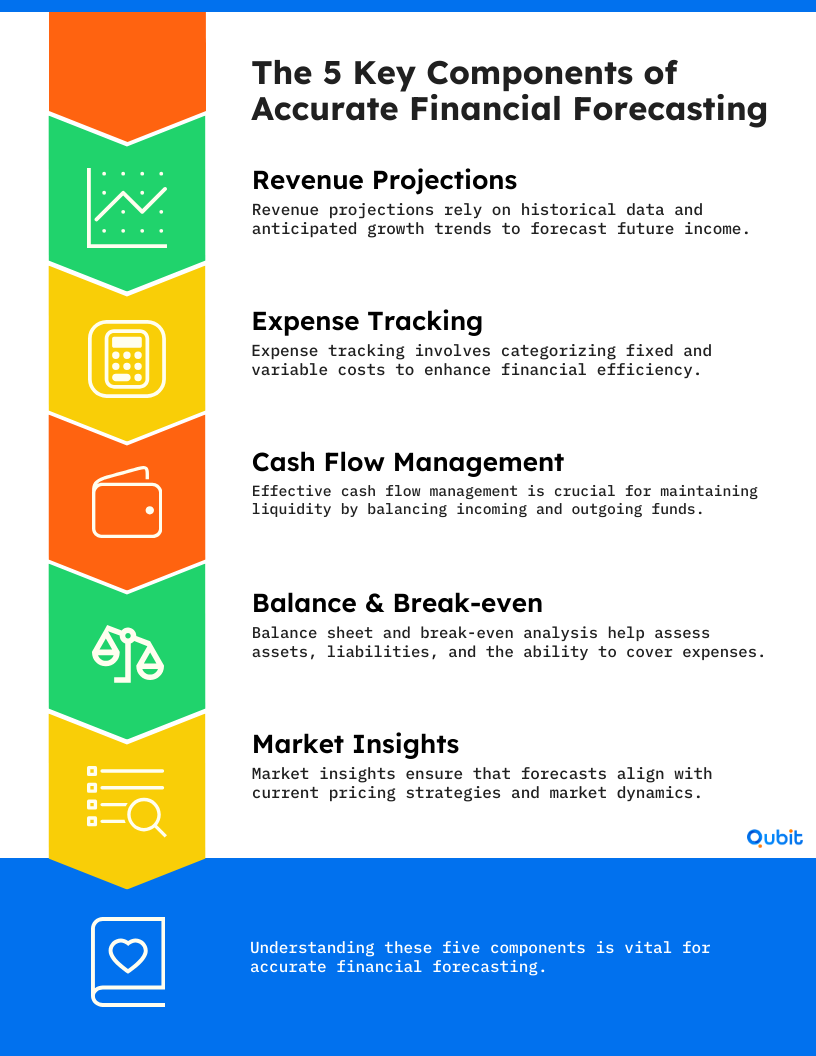One of the most critical tools for overcoming the challenges of your startup journey is financial forecasting. When you have a precise forecast of your startup’s financial future, you’re better equipped to make strategic decisions, distribute resources wisely, and mitigate potential risks. But what is financial forecasting, and why does it hold such importance for startups?
Financial forecasting refers to the process of estimating future financial outcomes based on historical data, market trends, and strategic assumptions. It provides startups with a roadmap to navigate uncertainties and align their operations with growth objectives. Accurate financial forecasting relies heavily on understanding financial statements for startup founders, as these documents serve as the foundation for making informed predictions. Without a clear grasp of your startup’s financial health, forecasting becomes guesswork rather than strategy.
This blog explores why financial forecasting matters and how it can shape the trajectory of your startup’s success.
Strategic Role of Financial Forecasting in Startup Success
Financial forecasting plays a pivotal role in shaping the trajectory of startups, offering clarity amidst the uncertainties of early-stage business operations. It involves analyzing past data and market trends to predict future growth. Startups use it to set realistic benchmarks for revenue, expenses, and cash flow. This process not only provides a structured approach to financial modeling basics for startups but also ensures that decisions are grounded in data rather than speculation.
Startups often face unpredictable market conditions, and financial forecasting helps anticipate challenges by modeling various scenarios. Multi-scenario analysis enables founders to prepare for both best-case and worst-case outcomes, ensuring agility in decision-making. For example, projecting cash flow under different market conditions allows startups to allocate resources effectively and avoid financial pitfalls.
Moreover, detailed forecasts build investor confidence. Investors seek assurance that a startup has a clear financial roadmap, and accurate projections demonstrate preparedness and strategic thinking. Creating accurate forecasts also involves knowing how to develop a financial roadmap for a startup, which provides a structured path for achieving financial goals. This roadmap not only supports internal planning but also strengthens external communication with stakeholders.
The importance of financial forecasting extends beyond immediate planning; it lays the foundation for sustainable growth. Startups that assess historical trends and key economic signals can transform unpredictability into actionable insights, ensuring sustainable growth and strategic alignment.
Components of Accurate Financial Forecasting
Crafting a reliable financial forecast requires a blend of precision and strategic insight. To ensure accuracy, businesses must focus on several critical elements, starting with realistic revenue projections.

- Revenue Projections: Base forecasts on historical data, current trends, and realistic growth expectations.
- Expense Tracking: Differentiate fixed and variable costs to pinpoint optimization areas.
- Cash Flow Management: Ensure inflows and outflows are balanced to maintain liquidity.
- Balance Sheet & Break-even Analysis: Assess assets, liabilities, and determine the revenue needed to cover expenses.
- Market Insights: Align pricing strategies and growth trends with target market dynamics.
Implementing finance management best practices for startups ensures that your financial forecasts remain grounded in practical and effective approaches.
Accurate financial forecasting isn’t just about numbers—it’s about understanding the bigger picture and making informed decisions that drive sustainable growth.
Exploring Types of Financial Forecasts to Secure Stability
Financial forecasting is a critical tool for businesses aiming to maintain stability and plan for growth. By examining different types of forecasts, organizations can make informed decisions that strengthen their financial health.
Revenue Forecasting: Predicting Future Sales Growth
Revenue projections estimate future sales growth by analyzing historical data, market trends, and customer behavior. This type of forecasting helps businesses anticipate income streams and align their strategies with expected demand. Accurate revenue forecasting also aids in setting realistic goals and identifying opportunities for expansion.
Expense Forecasting: Managing Fixed and Variable Costs
Maintaining financial stability requires both awareness and control over costs. Expense forecasting involves predicting both fixed costs, such as rent and salaries, and variable costs, like materials and utilities. By analyzing past spending patterns and adjusting for future changes, businesses can allocate resources effectively and avoid overspending.
Cash Flow Analysis: Ensuring Liquidity
Predicting cash flow is vital for liquidity management. Implementing effective cash flow measures can stabilize operations, ensuring that a company has enough funds to cover expenses and invest in growth. Forecasting provides actionable insights into inflows and outflows, helping businesses avoid financial bottlenecks.
Profit and Loss Evaluation: Determining Net Profitability
Combining revenue and expense data allows businesses to evaluate their profit and loss (P&L) performance. Integrating P&L insights can boost profitability by revealing areas for cost optimization and revenue enhancement. This analysis is crucial for understanding the overall financial forecast meaning and identifying strategies to improve margins.
Balance Sheet Projections: Assessing Financial Health
Balance sheet projections offer a comprehensive view of future asset, liability, and equity positions. By analyzing these elements, businesses can assess their overall financial health and prepare for long-term stability. This type of forecasting supports strategic planning and ensures that organizations remain resilient in the face of economic fluctuations.
Each type of financial forecasting plays a unique role in securing stability, enabling businesses to adapt to challenges and capitalize on opportunities.
Proven Best Practices for Startup Financial Forecasting
Effective financial forecasting is essential for startups aiming to make informed decisions and secure investor confidence. To achieve accuracy and adaptability, startups should follow proven strategies that align with dynamic market conditions.
1. Prepare Multiple Scenarios
Creating multiple financial scenarios allows startups to anticipate diverse outcomes. For example, a best-case scenario might project rapid growth, while a worst-case scenario accounts for unexpected challenges. This approach equips founders with a roadmap to adapt their strategies based on real-world developments. Before diving into specific forecasting strategies, it's important to understand how to create a financial model for investors, which lays the groundwork for accurate financial projections.
2. Base Forecasts on Realistic Assumptions
Overly optimistic assumptions can lead to misleading projections. Instead, startups should rely on data-driven insights and industry benchmarks to ensure their forecasts reflect achievable goals. Realistic assumptions provide credibility, which is crucial when presenting financial plans to stakeholders.
3. Regularly Update Forecasts
Market conditions and business dynamics evolve rapidly. Regular updates to financial forecasts ensure they remain relevant and actionable. Startups should schedule periodic reviews to incorporate new data, adjust assumptions, and refine projections.
4. Integrate Sensitivity Analyses
Sensitivity analyses help startups evaluate how changes in key variables—such as market demand or operational costs—impact their financial outcomes. This technique enables businesses to identify risks and opportunities, ensuring they remain agile in fluctuating environments.
5. Document Assumptions Systematically
Clear documentation of assumptions is vital for transparency and accountability. By maintaining detailed records, startups can track changes over time and provide stakeholders with a clear understanding of the rationale behind their forecasts.
Adopting these best practices ensures startups are equipped to make informed decisions while adapting to market shifts.
Why Investors Prefer Startups with Financial Forecasting
Investors love clear, data-driven forecasts. When businesses lay out their financial future with reliable numbers, it builds trust and opens doors for long-term partnerships. Here’s a casual take on how it all works:
- Credible Projections:
- Solid data makes your forecasts believable.
- Transparency in numbers reassures investors and builds confidence.
Mixing in multi-scenario forecasting shows you’re ready for any market twist. Creating different projections demonstrates your ability to adapt and stay ahead, which is key for winning over skeptical investors. This not only strengthens investor relations but also tips the scale during funding decisions.
- Adaptive Forecasting:
- Show various “what if” scenarios.
- Prove that you can thrive, even when the market throws a curveball.
Regularly comparing actual performance against your forecasts keeps your models sharp and relevant. This ongoing process refines predictions and reassures everyone that you’re on top of your game. It’s like fine-tuning an engine for peak performance.
- Performance Checks:
- Keep an eye on how real results stack up against forecasts.
- Use these insights to improve accuracy over time.
For startups, solid financial models are a must. They’re not just spreadsheets; they’re a story of strategic planning and discipline that can really sway funding decisions. Investors see these models as a sign that you mean business.
- Startup Essentials:
- Craft models that clearly show financial reliability.
- Let your numbers speak to your strategy and discipline.
To secure funding, startups must focus on creating financial models to attract investors, demonstrating the accuracy and reliability of their forecasts. These models serve as a testament to a company’s strategic planning and financial discipline, making them indispensable tools in investment discussions.
Ultimately, financial forecasting is not just about numbers; it’s about building a narrative that inspires trust and confidence among investors, paving the way for sustainable growth.
Robust Financial Forecasts Make for Effective Strategic Decisions
Effective financial lets you see the bigger picture—from future revenue and expenses to market trends—helping you choose the right moves when hiring, budgeting, or expanding into new markets.
- Data-Driven Moves:
- Forecasts reveal when it might be the perfect time to add team members or boost investments in thriving departments.
- They guide your resource allocation to support the best-performing areas of your business.
Staying on top of your forecasts is key. Markets can change on a dime, so regular reviews ensure your strategies are always in tune with current realities. This flexibility means you’re ready to pivot when unexpected challenges or new opportunities show up.
- Keeping It Fresh:
- Periodic check-ins let you adjust your strategy as market conditions shift.
- Regular monitoring catches discrepancies early, so you can make timely corrections.
Financial forecasting goes beyond crunching numbers—it’s about crafting a dynamic roadmap that grows with your business.
Conclusion
Accurate financial forecasting is more than a tool—it’s a cornerstone for strategic growth. Throughout this guide, we’ve explored essential strategies and actionable insights to help you refine your forecasting processes. By implementing these best practices, businesses can make informed decisions, anticipate challenges, and seize opportunities with confidence.
The importance of precise forecasting cannot be overstated, especially when it comes to securing investor trust and driving long-term success. Whether you're fine-tuning your projections or starting from scratch, the steps outlined here provide a solid foundation for achieving your goals.
If you're ready to turn your detailed forecasts into investor confidence, we at Qubit Capital are here to help with our Investor Outreach service. Let us support your journey toward growth and success.
Key Takeaways
- Accurate financial forecasting is vital for strategic planning and startup growth.
- Integrating historical data with realistic assumptions is key to reliable forecasts.
- Effective forecasting builds investor confidence and informs critical business decisions.
- Best practices include regular review, scenario planning, and sensitivity analysis.
- A comprehensive step-by-step guide empowers startups to implement robust financial models.
Frequently asked Questions
Why are financial projections important for startups?
Financial projections are crucial for startups as they provide a roadmap for growth and sustainability. By offering a clear picture of expected revenues and expenses, these projections help businesses manage cash flow effectively and identify potential challenges. Additionally, they instill confidence in investors by showcasing a transparent and realistic outlook on future performance.


 Back
Back



